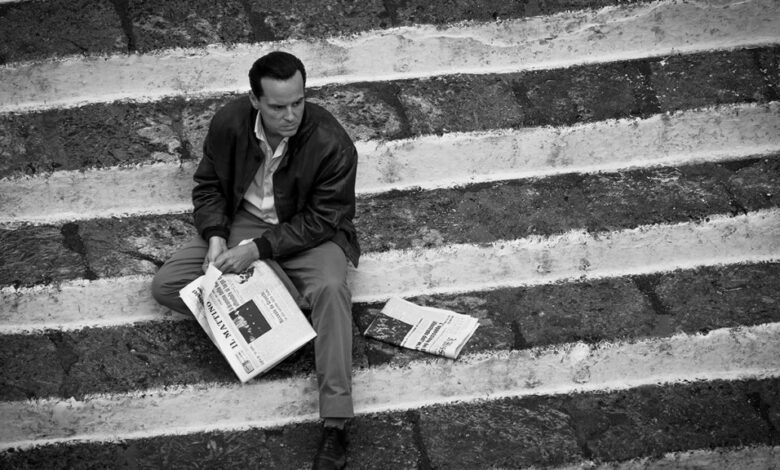‘Ripley’ Review: Andrew Scott and Dakota Fanning in Netflix’s Moody Fresh Take on Patricia Highsmith

The Italy of Anthony Minghella’s remarkable 1999 adaptation of The Talented Mr. Ripley is positively bursting with la dolce vita.
It’s an ebullient and passionate world of religious and artistic fervor and when Matt Damon’s Tom Ripley begins to kill to secure his place in that world, he does so with the improvisational flair of the Blue Note jazz albums he studied to help him assimilate. And who could blame Damon’s Ripley for desiring, by any means necessary, to stay? As photographed by the great John Seale, the entire cast of The Talented Mr. Ripley practically glows. Not to justify serial murder, but who among us wouldn’t kill to spend just a little more time close to this version of Jude Law, much less to become him?
Ripley
The Bottom Line
Another strong adaptation of the psychologically rich source material.
Airdate: Thursday, April 4 (Netflix)
Cast: Andrew Scott, Dakota Fanning, Johnny Flynn, Eliot Sumner, Maurizio Lombardi
Director-screenwriter: Steven Zaillian
Steven Zaillian‘s Netflix take on Patricia Highsmith’s novel has done away with the titular modifier. In Ripley, Andrew Scott‘s Tom Ripley is not, in fact, spectacularly talented. He’s a bit of a grinder, a desperate man who suspects this may be his only chance to get the life he thinks he deserves. He’s grim and calculating and the Italy around him matches the tone he sets. It’s a monochromatic setting of geometrically precise architecture, of voyeuristically leering statues and gargoyles, where every alley could hide a body, where every church could hide a towering Caravaggio canvas and every frame of Robert Elswit’s cinematography bears the influence of Caravaggio’s striking use of light and shadow.
In artistic terms, Zaillian’s Ripley — he wrote and directed all eight episodes — is a palimpsest, an adaptation that knows it’s standing on the shoulder of masterpieces, principally Minghella’s film and René Clément’s Purple Noon. But the series wastes no time finding its own style and tone that distinguish it from what came before.
Like its protagonist, Ripley is a slower and more methodical take on the character. “To a fault,” viewers looking for a more instantly visceral thrill ride might decide. But this is a milieu in which I was more than happy to linger. Carried by its careful adherence to a battle-tested story, Scott’s complex central performance and some of the most breathtaking photography the small screen has to offer, Ripley is a steady yet propulsive descent into murky morality.
Oh and lest anybody worry that it’s going to be too dark and too nihilistic, Ripley is also frequently hilarious, especially in the second half of the series when Maurizio Lombardi arrives as a sad-eyed investigator with little patience for Americans and their silly names and murders. The campaign for Lombardi’s Emmy nomination starts here.
You know the basic plot: Tom Ripley (Scott), in this version something of a low-level New York City con man circa 1961, is recruited by shipping magnate Herbert Greenleaf (Kenneth Lonergan, in one of several cheeky pieces of casting) to go to the Amalfi Coast of Italy and bring back his prodigal son, Dickie (Johnny Flynn). Herbert has become convinced that Tom and Dickie were friends. They were not.
Sensing that one of his scams is about to collapse anyway, Tom happily embarks for Atrani, where he becomes intrigued by and then obsessed with the life of leisure led by Dickie and his girlfriend Marge (Dakota Fanning). And who wouldn’t be? Dickie has a glorious and airy villa in the hills — lots of steps — overlooking the sea. He has a boat and an art studio and he and Marge are already talking about a Christmas spent skiing in Cortina with the otherwise odious Freddie Miles (Eliot “Sting’s Kid” Sumner, savvy casting on several levels). Who wouldn’t want to live this dream? Or kill for it? (Yes, I’m pretty sure I just guaranteed that none of my wealthy friends will invite me to Europe for the holidays.)
The elephant in the room, for viewers if not the characters, is that at 47, Andrew Scott is too old for the fledgling sociopath that Tom Ripley is supposed to be in the first of Highsmith’s novels in the series. He’s the right age for later Ripley adventures, in which the character goes from merely “talented” to borderline supernatural in his myriad gifts, with “escapability” first among them.
The series puts Scott in his 30s, a more plausible stretch, but this is still not miscasting and not just because without Scott, there would be no Ripley. The maturity has thematic purpose.
Through Zaillian’s eyes, Ripley takes the core story’s backdrop of privilege to a desperate extreme. It’s one thing for Tom Ripley to be an unformed if still protean grifter at 21 or 22, but another thing still to be scraping by without an identity at 35. It’s one thing for Dickie to be on a trust fund-fueled gap year of debauchery at 21 or 22, but another for him to be dabbling in his third or fourth different creative medium — his paintings are less-than-good — in his mid-30s. All of our “heroes” in Ripley are dabblers without evident talent. Marge is a photographer and author, but neither really. Freddie is an aspiring playwright, supposedly.
As much as Zaillian is focused on these wastrels, he’s nearly as interested in the people in the series doing their actual jobs — put-upon hotel clerks, exhausted postal workers and, eventually, Lombardi’s Inspector Pietro Ravin, whose distaste for touristic frivolity is palpable.
Damon’s Ripley was wholly worthy of empathy, no matter how uncomfortable it was to see yourself in his outsider status. Scott’s Ripley is much harder to get a read on — his obsession with Dickie isn’t explicitly erotic, but other characters are much more attuned to that possibility than in previous incarnations. He’s less inherently sympathetic, but there’s purpose in his desperation.
This is a version of Italy in which the land and its culture are eternal, but all our other main characters are past their expiration dates and Ripley is learning to find his own artistry in hastening that expiration. It’s not heroic, but I get it. (Look, since I’m not getting invited to Europe for the holidays…)
Rather than building suspense by making the audience wonder how Ripley will get out of his escalating — staircases are everywhere in Ripley, as everybody is aspiring to a labyrinthine upward mobility — scrapes, Zaillian builds stakes by having Ripley himself never be completely sure how he’s going to escape.
Just as Marge isn’t great at writing and Dickie isn’t great at painting, Ripley isn’t great at covering up murder. My fatigue with prestige cable’s body disposal obsession is well-established, but by showing Ripley’s attempted cover-ups in something resembling real-time — clever, intense and peppered with Grand Guignol humor — Zaillian has rejuvenated an entire genre. The series’ plotting is intricate, but Ripley’s own plotting is less preternaturally adroit. He’s promising, but too old to be a prodigy.
Scott blends Damon’s close-to-the-bone fragility and Alain Delon’s simmering impenetrability in making this uncertain Tom Ripley his own. He’s unsteady and forgettable one moment and suave and canny the next, completely believable navigating between the two.
Flynn isn’t the louche paragon that Dickie is regularly depicted as, but he casually conveys the over-ripeness of a man to whom much has been given, but from whom nothing has been expected. The writing is less consistent with Marge, flighty enough to be the frequent target of mockery, but still smart enough never to fully embrace Tom. But I appreciated how Fanning plays that uncertainty as a fickle girl treating maturity as ill-fitting dress-up. As for Lombardi, I liked Ripley before he showed up and loved it after his arrival, delivering a symphony of withering sourness and contempt.
I’m not going to claim there aren’t places where Ripley feels indulgently protracted — I don’t think I’m exaggerating when I say that if you trimmed the shots of staircases and leering sculptures, you’d lose an hour — but Zaillian and Elswit make the series so rapturously pretty that my attention never waned.
There will be some tendency, I’m assuming, to claim incorrectly that the black-and-white aesthetic is noir-inspired, when in truth it’s much more precisely and evocatively composed than that. The obvious inspirations include Hitchcock (with a direct and winking nod to another Highsmith adaptation, Strangers on a Train), Elia Kazan and especially Roberto Rossellini, whose Viaggio in Italia might be the series’ most surprising touchstone. Over eight episodes, the Italy of Ripley is brutal and banal, the stuff of cheap postcards and timeless paintings, but always beautiful.
The credits for the series refer to it as “Based on the Ripley novels,” when it’s almost exclusively The Talented Mr. Ripley (threads from later novels are more of an in-joke). It required almost a five-year journey just to get this one season to Netflix. But if the streamer treats Ripley as a drama instead of a limited series, it’s the sort of smart and meticulously produced literary adaptation — think TV for grownups in a Queen’s Gambit or The Crown vein — that’s worthy of across-the-board award consideration. More importantly for this Highsmith fan, it’s worthy of extending into future installments.



